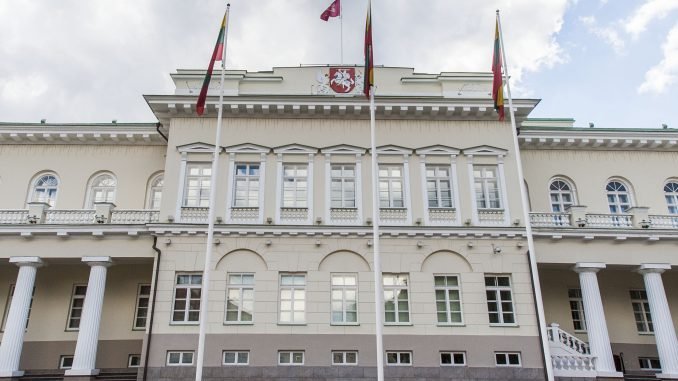
A month has passed with President Gitanas Nausėda in office, the so-called honeymoon. Compared to an analogous period of Dalia Grybauskaitė’s first term, the impression arises that the new head of state’s relations with both the nation that elected him and with politicians are much better lrytas.lt writes in its editorial Laiko ženklai.
The first difference that stands out is that unlike D. Grybauskaitė, G. Nausėda has sought to interact with people as much as possible.
He began to demonstrate his style of being open to the public already in his inauguration, organising a reception in the Presidential Palace along with the style of Valdas Adamkus’ times, unlike D. Grybauskaitė, who had completely ceased such functions.
She motivated such a decision through economic hardship, but despite the crisis has passed, the traditional receptions would not be organised, even on Statehood (Mindaugas’ Coronation) Day.
Another difference is clear – G. Nausėda is always accompanied by his spouse D. Nausėdienė. Perhaps having not created a family, lonesome D. Grybauskaitė felt uncomfortable in receptions, thus ending them and thrift was simply a populist cover for personal challenges.
Of course, travels through Lithuania, meetings with people and smiles are more intended to create the image of a president, who is close to the nation, but it is not an insignificant formality.
After a decade of the grim, making everyone shiver D. Grybauskaitė, who was dubbed the Steel Magnolia, Lithuania longed for a different head of state – friendly, intellectual, open to dialogue.
Thus far, G. Nausėda has fulfilled these expectations: his ratings are rising, he now also has the sympathies of some voters that did not support him.
That said, some political analysts doubt whether the non-confrontational, seeking to get along with all political powers president will not be excessively lenient and whether he can resist the dictate of the Seimas majority.
The first month of G. Nausėda has not left all that much space for such concerns, though he did approve a cabinet that adhered to the majority’s wishes. The head of state expressed doubt over five ministers’ work, three changed.
Without a doubt, the new cabinet is a compromise, which leaves the Conservatives in particular dissatisfied, with them having openly urged to keep the office of minister of transport and communications with R. Masiulis, to fire Minister of Healthcare A. Veryga, who is close to the “Farmer” leader and to reject the Electoral Action of Poles’ candidates.
Of course, the opposition had a basis to be disappointed – having used up almost all the time allowed to coordinate minister candidacies, G. Nausėda, without any public conflicts, approved a cabinet composition that satisfied the ruling coalition.
How the negotiations proceeded and who yielded more ground was left behind closed doors.
But is this bad for Lithuania? We may want a more professional cabinet, but the president’s priority is state stability.
The “Farmers” are torn by internal discord, a leadership crisis is evident, their partners are uneasy, struggling to find a position on the political map. Under such conditions, the president can impose his will, but this also causes the risk of political chaos and upheaval. G. Nausėda chose a peaceful path.
It is worth recalling that upon her first time becoming head of state, D. Grybauskaitė replaced only one member of A. Kubilius’ cabinet – Minister of Social Security and Labour J. Dagys, who left his talk with the president as if beaten up, with his head down.
While D. Grybauskaitė’s relations with the Conservatives were fairly good, she did not shirk demeaning remarks when approving even a cabinet dominated by the party, declaring that some of its members might not be all that great, but at least they don’t steal.
Later cabinets were far more impacted by the president, who organised demeaning exams for the ministers, but at the same time sought to distance herself from accountability for their work, took the position of a flawless side-line critic.
G. Nausėda, who has presented an idea of creating a welfare state, is likely going to feel more associated with the results of the cabinet’s work. But by no means will it force him to be lenient to the majority.
This is proven by the fact that already in his first month of work, G. Nausėda has vetoed four laws, while D. Grybauskaitė did not veto a single one in the same period. Furthermore, he did not approve of the cabinet’s proposed candidacy, V. Valančius to become a judge at the EU General Court, but this was done without any noise.
Lithuanian foreign and security policy guidelines are mostly drawn by the country’s membership in the EU and NATO, the threat posed by Russia, thus experts expect no major changes from G. Nausėda. Nevertheless, accents and rhetoric will change.
G. Nausėda’s visits thus far in order: Poland, Latvia, Germany, Estonia. His predecessor first visited Sweden, then Latvia.
D. Grybauskaitė also declared that she will focus on Northern Europe, also Germany, meanwhile dedicating no attention to Eastern Partnership policy initially, even insultingly declaring that it is not worth being friends with paupers. Only Russian aggression in Ukraine made her change tone.
The first visits show that G. Nausėda will particularly strive to strengthen relations with neighbours, will seek to revive the forgotten strategic partnership with Poland and breathe new life into the fading Baltic States cooperation.
A difficult challenge awaits here because the ambiguous attitudes of Latvia and Estonia toward Astravyets Nuclear Power Plant imply that D. Grybauskaitė was unable to unite the Baltic States on even this question of particular importance to Lithuania.


Be the first to comment